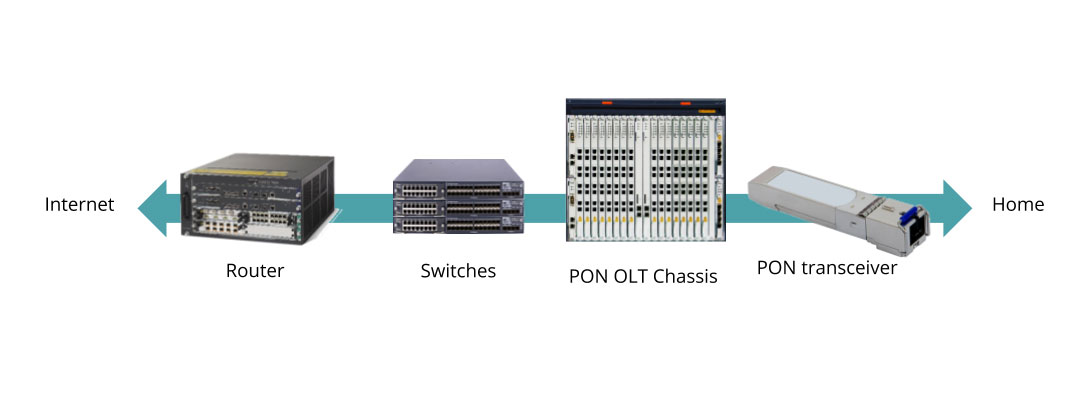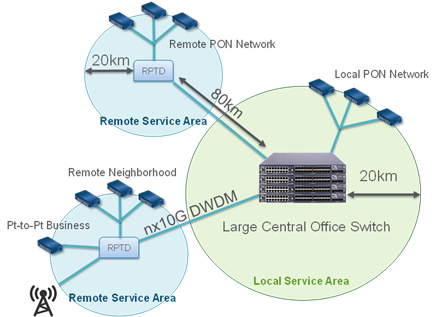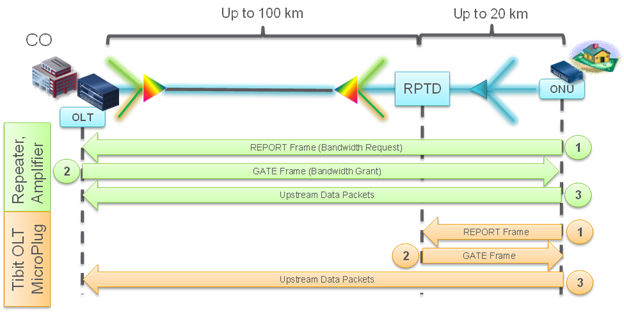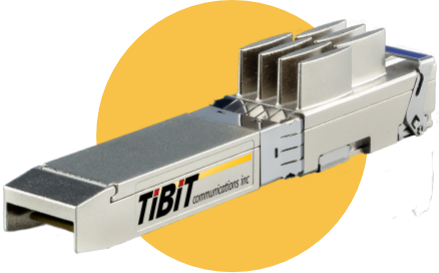Architecture

Introduction
The Tibit MicroPlug Modules are key pieces of technology in the design of a next generation OLT. Tibit OLT modules can be used to create higher density or more flexible versions of today’s integrated solutions. Additionally, the Tibit OLT module can be used to create forward looking Virtual or Distributed OLT system solutions. In all cases, the Tibit OLT Module provides the application specific portion of an OLT in a single pluggable form factor. An integrated Bridge chip allows the Tibit MicroPlug module to connect a PON Network to a point-to-point Ethernet SFP+ socket that is commonly found on Ethernet switches, routers, and many other optical networking devices. The Bridge chip contains an embedded processor to allow for in-band module control and configuration locally or remotely over an Ethernet switching infrastructure. Tibit provides both EPON and GPON PON flavors of the modules at 10Gbps speeds. The PON modules provide standard compliant interfaces that allow for compatibility with many readily available ONUs and ONTs on the market.
A PON access system can be created by combining the Tibit OLT module with a Network Function Virtualization Software layer, Ethernet Routers, Ethernet Switches, and other white box solutions. Existing OLT blades can achieve higher density and greater flexibility by using the Tibit MicroPlugs locally or remotely. The Tibit MicroPlug does not require or dictate a particular architecture. The MicroPlug allows the operator to flexibly select the architecture that fits the requirements. This document gives an overview of the system requirements to provide a PON access solution using the Tibit MicroPlug OLT module.
Today’s OLT Platforms
The Optical Line Terminal (OLT) provides an integrated access box for Passive Optical Networks. The OLTs are created with multiple layers of switching and traffic management. A PON line card has a traffic management Ethernet switch with PON MACs and PON transceiver sockets. A secondary switch provides line card aggregation to the Ethernet uplinks. OLTs are often a mixture of Layer 2 and Layer 3 switching with traffic shaping on a per-customer, per-service basis.

The OLTs are often managed by a proprietary Network Management System (NMS) for most TELCO applications. For MSOs, the OLTs may integrate the DOCSIS Provisioning over EPON (DPoE) management software interfaces. With this software, the OLT can have a Command Line Interface (CLI) like a Cable Modem Termination System (CMTS) and gather provisioning for DOCSIS configuration files.

From a functional point of view, the OLT has control software, Layer 2/3 switching, the PON MAC layer, and the PON Physical layer (optics). Behind the OLT, the network would normally contain Ethernet Switches for aggregation and a router to the internet.
Evolution of the OLT Architecture
Data centers have benefited from the emerging Software Defined Networking (SDN) and Network Function Virtualization (NFV) movements. High performance systems based on x86 processors and specialized software allow for flexible and low cost devices. Low cost Ethernet switches continue to dominate the market with many flavors of port count and speed. If access systems could utilize these devices, they could have lower cost and benefit from the significant investment. Additionally, if the complex functions could be serviced directly from the data center, the operator could significantly decrease the cost and improve the overall system performance.

The functionality of the OLT can be split into multiple pieces to align with the generic network functions and isolate the PON access system specific pieces. The Tibit OLT MicroPlug contains the PON specific functions including Bridging, MAC Layer, and Physical Layer Optics. The rest of the system can be generic functions of Layer 2 switching for aggregation and Layer 3 switching with traffic management and routing. These generic devices can be leveraged from the data center and use SDN for orchestration. Significant cost savings can be achieved by removing the application specific hardware and replacing it with best in class Ethernet switches. Significant flexibility can be achieved by selecting PON or point-to-point Ethernet on a port by port basis.
Virtual OLT

The Tibit MicroPlug module can provide a single PON port of a Virtual OLT. Switches and Routers can provide the data plane for the OLT while a software function is required to merge the single OLT ports and numerous ONUs into a logical OLT system and tie it together with the other data plane devices. The Virtual OLT software communicates to the OLT modules and ONUs over via dedicated VLANS per OLT port (Layer 2 Ethernet OAM). (AT&T) dedicates an SVLAN to multicast. For high speed internet, they use a single VLAN per OLT port and a CVLAN for the ONU on the OLT. Our OLT strips the SVLAN tag and the ONU strips the CVLAN tag. They use a single SVLAN tag for business customers that passes through the OLT and ONU. The SVLAN values are configured from the SDN software. They also reserve a few SVLAN values for OLT and ONU management.
The north bound interface from the Virtual OLT could be DOCSIS management interfaces (TFTP, SNMP, etc.), a TELCO EMS, or SDN (NETCONF, RESTAPI, etc.) interfaces. Tibit provides the embedded firmware for the module and a low layer API to communicate with the Tibit module. The Virtual OLT software can be run on the hosting switch/router or on a server centralized in the network. The Virtual OLT software communicates to the Tibit modules to configure and manage the subscribers and the ONUs. The higher layer software could be developed internally by system vendors or licensed from third party software companies.
PLOAM support in the chip? PLOAM cells are generated and processed in the chip. The NFV software triggers, enables, or configures the functions in the PLOAM cells. OMCI support in the chip? OMCI messages are generated in the NFV software and encapsulated in Ethernet OAM to reach the Tibit Module. The Tibit module will remove the OAM encapsulation and send the messages over OMCI.
Scheduler in the chip? The upstream scheduler is in the Bridge chip. The downstream scheduler is a simple priority scheduler. Downstream traffic management of per-customer and per-service should be done before reaching our module
Distributed OLT

The Distributed OLT is a Virtual OLT where the Tibit OLT modules are distributed in multiple remote locations. The Tibit MicroPlugs have outside plant versions that allow for placing the PON in small outside plant enclosures such as a cable node housing. The Remote PON Termination Device (RPTD) is a simple device that hosts the remote OLT port. These devices are often placed in the outside plant to extend the reach or density of the fiber. In contrast to repeater, PON extender, or optical amplifier solutions, the Distributed OLT has the same PON MAC distance and split ratio as a normal PON link. By preserving the split ratio and distance, the PON system does not require special ONUs or suffer efficiency loss with large increases in the packet delay/jitter.

The Tibit OLT MicroPlug has significant performance advantages over optical amplifiers, PON extenders, or PON repeaters that extend the PON MAC layer over a longer PON physical layer. The longer PON MAC layer can dramatically increase the upstream delay by running the PON controls frames over the longer trunk fiber. The increased delay puts significant burden on the upstream buffering of the ONU and often will require special ONUs with large external memories. In all cases, it will increase the delay and jitter of the PON upstream and often beyond the limits of the MEF23 standards. In contrast, the Tibit MicroPlug OLT runs the PON protocol over the same distance (<20km) as a normal PON network. The same ONUs can be used and the same jitter performance will be seen. The delay will be increased by the fixed one way delay on the trunk fiber. Additionally, there is no distance limitation on the trunk fiber due to the PON OLT MAC layers that have a maximum distance between 50km to 80km.
The Distributed OLT uses the Virtual OLT concept to remove complexity from the outside plant device. The Virtualization allows for a lower power and more reliable solution in the outside plant. The virtualization also allows the operator access to the complex functions to upgrade or modify functionality. A Remote PON Termination Device (RPTD) can extend the reach of a centralized switching solution in the central office to include smaller remote neighborhoods. The same Ethernet switching network can be used to connect point-to-point subscribers or high bandwidth wireless. RPTD must be very simple, small, and very low power. These devices are often line powered and without cooling. The RPTD will often need to share precious space with other outside plant node electronics. Reliability is very important. Using Tibit MicroPlugs, a simple, flexible, low cost, and low power solution for servicing remote PONs can be created from an Ethernet switching network.

In the simplest RPTD for the Distributed OLT solution, a long reach point-to-point Ethernet link connects to a Tibit MicroPlug OLT module in an outside plant enclosure. The outside plant solution is two SFP+ sockets with power. A PON ONU module or a WDM optics module can be used as the uplink while any speed of OLT module can provide the required PON module. The in-band management allows for configuration and control of the module and ONUs over Ethernet OAM.

For higher density remote deployments, an outside plant Ethernet Switch can be placed in the outside plant enclosure. Multiple Tibit OLT modules can be plugged in and aggregated to the trunk WDM link. The outside plant device can be a low cost Ethernet switch with multiple SFP+ sockets. The number of remote PONs, speed of the PONs, speed of the uplink, and number of uplinks is selectable based on the modules plugged into the switch. All modules can be managed remotely through the Ethernet OAM so a complex network management system in the outside plant is not required. Tibit’s cascaded switching technology allows an internal buffer Ethernet switch to act as an aggregator in the outside plant without QoS provisioning or packet loss. The software required in the outside plant solution is minimized to lower the complexity and increase the reliability.

Tibit Microplug
TiBiT Communications, Inc. offers a disruptive technology that will fundamentally change the way broadband access is deployed in the worldwide Cable MSO and Telco markets. We make small, low powered solutions that can be easily placed anywhere in the network, connecting different types of networks in a cost effective way.
